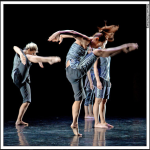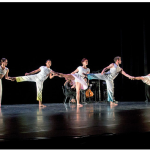 Rabbi Hillel? Really? According to a number of sources that you figure had decent fact-checkers—like O Magazine and Anne Lamott’s Bird By Bird—Rabbi Hillel wrote the following bit of Zen:
Rabbi Hillel? Really? According to a number of sources that you figure had decent fact-checkers—like O Magazine and Anne Lamott’s Bird By Bird—Rabbi Hillel wrote the following bit of Zen:
“I get up. I walk. I fall down. Meanwhile, I keep dancing.”
I was so charmed by this saying when I first encountered it, in Bird By Bird, that I copied it and tacked it to the wall above my desk. Nevertheless—and with great respect for Anne Lamott, whose wisdom has helped me survive many a writing meltdown—I have trouble believing that Rabbi Hillel said anything of the kind.
In case you’re not familiar with Rabbi Hillel, he was the head of Palestinian Judaism in the first century. He’s often discussed in terms of his debates with a rival scholar, Shammai. Shammai took the rigorous, by the book approach; Hillel was more compassionate and invariably won their arguments.
It’s true that Hillel is known for wise sayings. Asked to teach the whole of Judaism while standing on one foot, he said: “That which is hateful to you, do not do to your neighbor. That is the whole Torah; the rest is commentary.” Another gem is: “If I am not for myself, who is for me? And if I am only for myself, what am I? And if not now, when?” This one generated some buzz last year, when the center of the Boston Bruins wrote it on his hockey stick.
And Hillel is known for practical as well as spiritual teachings: he invented the Hillel Sandwich, bitter herbs (and, in his time, meat) between two pieces of matzah, eaten at the Passover seder.
 But “I get up. I walk. I fall down?” It doesn’t sound like the literary style of the man who wrote, “Whoever has acquired the words of the Law has acquired the life of the world to come.” And, in a perusal of on-line information about Hillel, the quote doesn’t appear.
But “I get up. I walk. I fall down?” It doesn’t sound like the literary style of the man who wrote, “Whoever has acquired the words of the Law has acquired the life of the world to come.” And, in a perusal of on-line information about Hillel, the quote doesn’t appear.
I’m apparently not the only one to doubt Rabbi Hillel’s authorship of this aphorism. In a Google search, it’s often attributed to “Daniel Hillel, American writer.” Look up “Daniel Hillel, writer,” though, and you get an Israeli scientist known for developing micro-irrigation techniques that have made the Negev Desert bloom. Like the first-century rabbi, Daniel Hillel has done a lot of good. In 2012, he won the World Food Prize. And he doesn’t just focus on science. One of his books is The Rivers of Eden: The Struggle for Water and the Quest for Peace in the Middle East.
Still, it’s hard to believe the author of Environmental Soil Physics wrote the Zen-like dancing comment. So who did? I considered Marianne Williamson, the real author of an inspirational message often attributed to Nelson Mandela: “We ask ourselves, who am I to be brilliant, gorgeous, etc.”—remember that one?
I did find a graphic image of the dancing quote where it was attributed to Hillel Goldberg, a Colorado rabbi and author. There are quite a few Buddhist Jews in Colorado, so Rabbi Goldberg is my best bet.
But I’m still waiting for proof of the real author. Meanwhile, I keep dancing.
Thanks to Manny Rotenberg for allowing me to use some of his beautiful dance photos … and for sharing the lyrics of this Yiddish song: “Sha! Shtil! Der rebbe tanzt” – Shh!, Quiet! The rabbi’s dancing!
Mystery solved! At least partly…
Dan Bloom, a fellow writer for San Diego Jewish World, tracked down Daniel Hillel, the Israeli scientist, and asked if the quote was from him. He said yes, though he couldn’t remember if he made it up himself or he’d heard it somewhere. Whether he came up with the saying or not, the scientist is a poet. He ended his note with, “May the Dans bloom.”